You need:
- colored cardboard A3 size
- sponges
- paint rollers
- strips of ribbed cardboard
- bubble wrap
- tempera paint
- brushes
- scissors
- glue
A site with school-tested lessons for the Arts.
 Start this lesson with the symbol of the Olympics: the colored rings. What do these rings mean? What colors do they have? How are they placed together?
Start this lesson with the symbol of the Olympics: the colored rings. What do these rings mean? What colors do they have? How are they placed together?
 Ask one or two children to take the position of an athlete. What is the position of the legs, arms and body? Ask another student to show another position and discuss it again.
Ask one or two children to take the position of an athlete. What is the position of the legs, arms and body? Ask another student to show another position and discuss it again. Step two:
Every student takes a copy of the body and cuts every part of it. Then these bodyparts have to be pasted around, in, behind and in front of the Olympic rings.
Step two:
Every student takes a copy of the body and cuts every part of it. Then these bodyparts have to be pasted around, in, behind and in front of the Olympic rings.
Also talk about Victory Boogie Woogie, the painting in which you can see part of the map of New York. Tell students we are going to make our own Mondrian map. Discuss the terms primary colors, square, rectangle, vertical and horizontal lines.
You need:
Typical for Impressionists:
You need:
by students of grade 3
You need:
I did this lesson in grade 5, students worked in pairs. The figures are cut before class. Per art work you need 4 black squares and 16 colored rectangles
You need:
Made by a student of grade 5
You need:
Painting without using your hands is quite a challenge! You can paint with your feet or mouth. We tried both.
Painting with your feet
Put tables aside, newspapers on the floor and stick drawing sheets on top. Very important: take off the shoes in the hallway and leave them there 😀
Place a container with three colors tempera paint between two students. A beautiful portrait is too much, so ask them to paint simple lines or shapes.
Painting with your mouth
This is less difficult. Cover the tables with newspapers. Place jars with diluted water color paint and brushes. Students may paint what the want. You may also give them a simple goal: paint rectangles in different colors.